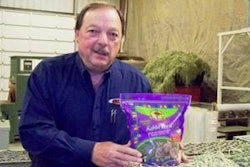Production in the Brazil animal feed industry decreased about three percent in 2012, according to data from Sindirações, the Brazilian Feed Industry Association. Broiler feed has nearly half the market share, but was down two percent from the previous year, and fish feed’s share increased the most, at 15 percent.
Dr. Ariovaldo Zani, Sindirações CEO, said the industry produced nearly 62 million metric tons of animal feed, compared to 64.5 million metric tons one year ago. In addition, 2 million metric tons of animal feed supplements were produced.
The figures in the Sindirações report were based on actual figures from January through September 2012, and projected estimates for the remaining months.
Broiler feed
Brazil’s broiler industry represented an estimated 48 percent of the overall feed demand in 2012, reaching about 30 million metric tons. This is down two percent and two metric tons from a year ago.
Layer feed
The production of feed for laying hens was projected to hit 5.2 million metric tons in 2012, up 0.3 percent from a year ago, in response to the housing estimates of more than 85 million laying chicks.
Beef cattle feed
Beef cattle feed came in at 2.6 million metric tons, down nearly 3 percent from 2011, while the feedlot rate remained mostly steady.
Dairy feed
There was a 2.5 percent decline in production with 4.9 metric tons of feed for dairy cattle, the result of reduced investment in dairy activity in an attempt to improve its gross margin that has been hurt by high feed costs and low prices paid for milk.
The limitation in the milk supply is also intensified because of drought, Zani added.
Swine feed
Revenues in pork exports increased by 4.5 percent, as well as 12 percent for the amount shipped, despite Russian and Argentine embargoes.
Considerations and forecasts
With the potential of domestic and international demand for animal proteins, the projections for 2020 show a production of about 40 million metric tons of broiler feed, 6 million metric tons for laying hens, 19 million for swine, 3 million for beef cattle, 7 million for dairy cattle, about 1 million for fish and shrimp, 3.5 million for dogs and cats, and 2 million more for goats, sheep, horses and other domestic livestock. The demand for supplements may result in the production of nearly 5 million metric tons, Zani said.
“The domestic [animal] feed industry has struggled to mitigate the current challenges and contributed greatly to the sustainability of the Brazilian animal protein production chain,” said Zani.
















